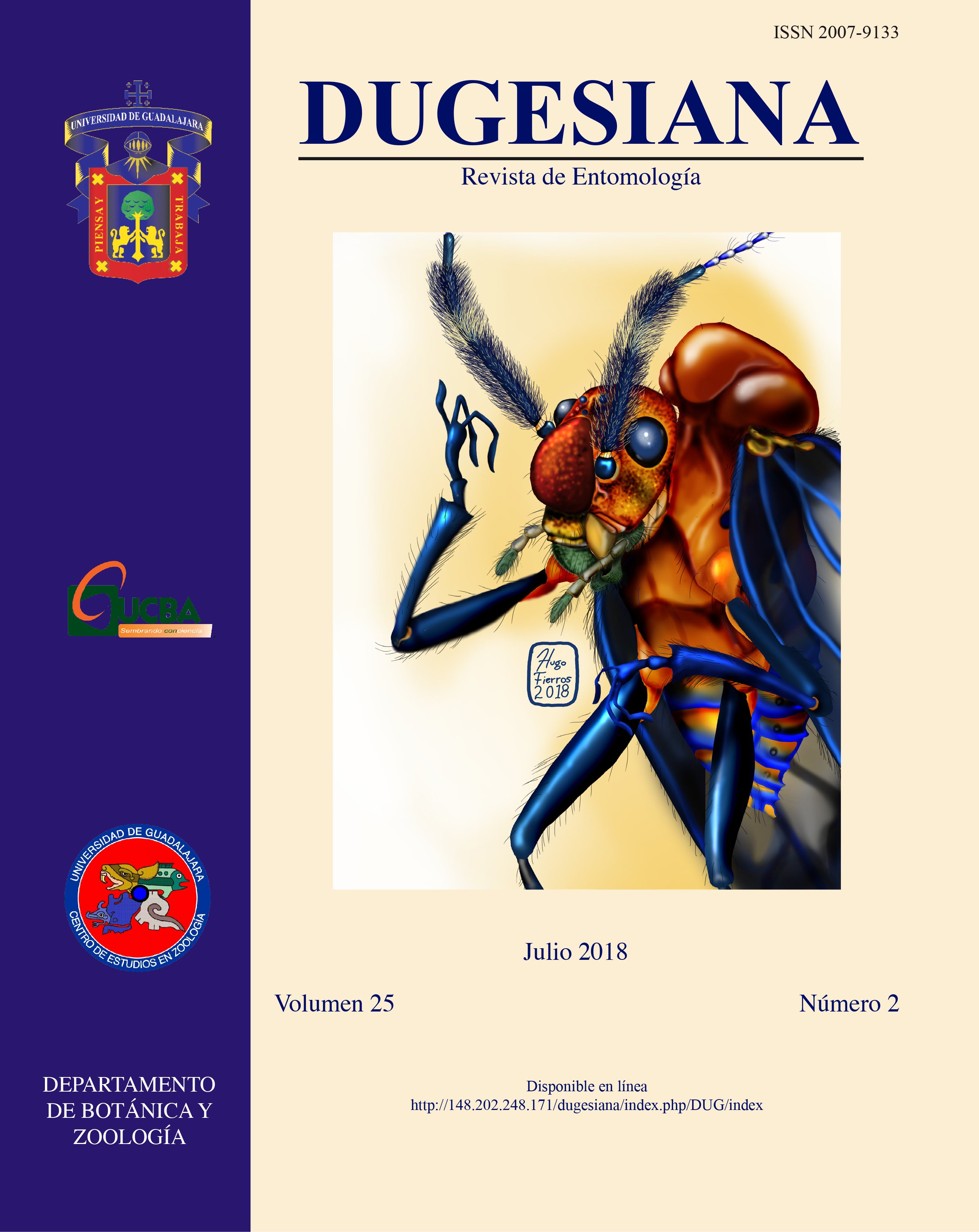First record of Embiratermes ignotus Constantino 1991 (Termitidae: Syntermitinae) in Colombia
DOI:
https://doi.org/10.32870/dugesiana.v25i2.7024Keywords:
First record, tsbf, EmbriatermesAbstract
Embiratermes parvirostris Constantino 1992 is recorded for the first time in Colombian Amazon in soil of secondary rain forest. With current report E. parvirostris distribution is not only restricted to east and southwest Amazon, but includes northwest Amazon too. But, the distribution of this species continues being restricted to the Amazon basin.References
Abadía, J. C. and A. Arcila. 2009. Termitas en cultivos de limón en los departamentos del Atlántico y Magdalena, Colombia. Boletín Del Museo de Entomología de La Universidad Del Valle, 10(2): 36–46.
Anderson J.M. and J. Ingram. 1993. Tropical soil biology and fertility: a handbook of methods. CAB International, Wallingford, UK
Bandeira, A.G. and A. Vasconcellos 2002. A quantitative survey of termites in a gradient of disturbed highland forest in northeastern Brazil (Isoptera). Sociobiology. 39 (3): 429-439.
Barros, E., B. Pashanasi, R. Constantino, and P. Lavelle. 2002. Effects of land-use system on the soil macrofauna in western Brazilian Amazonia. Biology and Fertility of Soils. 35(5): 338–347.
Constantino, R. 1991. Termites (Isoptera) from the lower Japurá River, Amazonas State, Brazil. Boletim do Museu Paraense Emílio Goeldi, Série Zoologia. 7 (2): 189-224.
Constantino, R. 1992. Notes on Embiratermes Fontes (Isoptera, Termitidae, Nasutitermitinae), with descriptions of two new species from Amapá State, Brazil. Boletim do Museu Paraense Emílio Goeldi, Série Zoologia. 8 (2): 329-336.
Constantino, R. & Cancello, E. M. 1992. Cupins (Insecta, Isoptera) da Amazônia Brasileira: distribuição geográfica e esforço de coleta. Revista Brasileira de Biologia. 52 (3), 401-413.
Constantino, R. 2017. On Line Termite Database. http://164.41.140.9/catal/advsrch.php. Fecha de consulta: 23 de agosto de 2017.
Davies, R.G., L.M. Hernández, P. Eggleton, R. K. Didham, L. L. Fagan, and N. N. Winchester. 2003. Environmental and spatial influences upon species composition of a termite assemblage across Neotropical forest islands. Journal of Tropical Ecology 19: 509-524.
Engel, M.S., D.A. Grimaldi, and K. Krishna. 2009. Termites (Isoptera): their phylogeny, classifiation, and rise to ecological dominance. American Museum Novitates. 3650: 1–27.
Eggleton, P., D. E. Bignell, W. A. Sands, N. A. Mawdsey, J. H Lawton, T. G Wood, and N. C. Bignell. 1996. The diversity, abundance and biomass of termites under differing levels of disturbance in the Mbalmayo Forest Reserve, Southern Cameroon. Philosophical Transactions of the Royal Society B: Biological Sciences. 351: 51–68.
Fontes, L.R. 1985. New genera and species of Nasutitermitinae from the Neotropical Region. Revista Brasileira de Zoologia. 3(1): 7-25.
Gutiérrez, A. I., S. Uribe, and J. Quiroz. 2004. Termitas asociadas a plantaciones de Eucalyptus spp. en una reforestadora en Magdalena, Colombia. Manejo Integrado de Plagas Y Agroecología, 72: 54–59.
Krishna, K., D. A. Grimaldi, V. Krishna, and M. S. Engel. 2013. Treatise on the Isoptera of the world: Vol. 4 Termitidae. Bulletin of the American Museum of Natural History. 377: 977 - 1423
Lavelle, P., D. E Bignell, and M. Lepage. 1997. Soil function in a changing world: the role of invertebrate ecosystem engineers. European Journal of Soil Biology. 33: 159–193.
Pinzón, O. P., A. M. Hernández, and L. A. Malagón. 2012. Diversidad de termitas (Isoptera: Termitidae, Rhinotermitidae) en plantaciones de caucho en Puerto López (Meta, Colombia). Revista Colombiana de Entomologia, 38(2): 291–298.
Rocha, M.M., E. M. Cancello, T. F. Carrijo. 2012. Neotropical termites: revision of Armitermes Wasmann (Isoptera, Termitidae, Syntermitinae) and phylogeny of the Syntermitinae. Syst. Entomol, 37: 793–827.
Rocha, M. M., A. C. Morales-Corrêa e Castro AC, C. Cuezzo, E. M. Cancello. 2017. Phylogenetic reconstruction of Syntermitinae (Isoptera, Termitidae) based on morphological and molecular data. PLoS ONE, 12(3): e0174366. https://doi.org/10.1371/journal. pone.0174366.
Vargas-Niño, P., O. D. Sánchez-Muñoz, and F. J. Serna- Cardona. 2005. Lista de los géneros de Termitidae (Insecta: Isoptera) de Colombia. Biota Colombiana, 6(2): 181–190.
Published
Issue
Section
License
1. Proposed policy for open access journals
Those authors who have publications with this journal, accept the following terms:
- The authors will retain their copyright and will guarantee to the journal the right of first publication of their work, which will be simultaneously subject to the Creative Commons Recognition License, which allows third parties to share the work whenever their author is indicated and His first publication is this journal.
- Authors may adopt other non-exclusive license agreements to distribute the version of the published work (eg to be deposited in an institutional telematic file or published in a monographic volume) provided the initial publication is indicated in this journal .
Authors are encouraged and encouraged to disseminate their work through the Internet (eg in institutional telematic files or on their web page) before and during the sending process, which can produce interesting exchanges and increase appointments Of the published work. (See The effect of open access).
2. Proposed policy for journals that offer open deferred access
Those authors who have publications with this journal, accept the following terms:
- The authors will retain their copyrights and will guarantee to the journal the right of first publication of their work [SPECIFY PERIOD OF TIME], which will be simultaneously subject to the Creative Commons Recognition License that allows third parties to share the work always That its author and his first publication be indicated this journal.
- Authors may adopt other non-exclusive license agreements to distribute the version of the published work (eg to be deposited in an institutional telematic file or published in a monographic volume) provided the initial publication is indicated in this journal .
- Authors are encouraged and encouraged to disseminate their work through the Internet (eg in institutional telematic files or on their web page) before and during the sending process, which can produce interesting exchanges and increase appointments Of the published work. (See The effect of open access).




